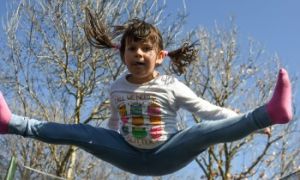

The Quality Areas are central to the National Quality Standard (NQS), which promotes high-quality outcomes for children in early education and care. The following article provides information on an Overview Of Each Quality Area, Connecting Quality Areas To National Law and Regulations, Strategies For Implementing Quality Areas, Tools That Can Assist In Implementing Quality Areas and more.
Quality Area 2 of the National Quality Standard focuses on children's health and safety. This area is to safeguard and promote children’s health and safety, minimise risks, and protect children from harm, injury, and infection. The following article provides a list of critical reflection questions to guide thinking and practice for QA2.
Quality Area 1 of the National Quality Standard focuses on Educational Program and Practice. This area ensures that the educational program and practice are stimulating, engaging, and enhance children's learning and development. The following article provides a list of critical reflection questions to guide thinking and practice for QA1.
The National Quality Standard includes seven quality areas, in each quality area includes standards. These standards are high-level outcome statements. Under each standard are elements that describe the outcomes that contribute to the standard being achieved within the service. The following lists the documentation services that are required to have in order to support the achievement of each quality area from 1 to 7.
Quality ratings for early educational services are determined based on the National Quality Standard (NQS) and are designed to ensure high-quality education and care for children. The following article provides information on the Quality Ratings, the Quality Areas, the Assessment Process, What Happens For Services With A Rating Of Significant Improvement Required, Displaying The Quality Ratings and more.
The aim of Quality Area 1 is to ensure that the educational programs and practices of educators are child-centred, stimulating and maximise opportunities for enhancing and extending each child’s learning and development. In the school-age care context, the aim of this Quality Area is to see that the program nurtures the development of life skills and complements children’s experiences, opportunities and relationships at school, at home and in the community. The following article provides FDC Compliance Responsibilities Of QA1, Documentation Of Assessment, How Compliance Is Monitored, Consequences For Non-Compliance and more.
The National Quality Area Reflection Questions Posters area is to be used as a guide for reflecting on each of the standards within each area. Use the information from these questions to recognize good practise or to change and improve what is not working well. It can also be used as part of a Self-Assessment or Quality Improvement Plan. These can be used as a display within the staff room or put into a folder to assist Educators in reflecting.
Quality Area 7 - Governance and Leadership enables services to achieve the best outcomes for children and their families by creating a service with skilled and engaged workforce, sound administrative and risk management systems, well documented policies and procedures, and a safe and healthy learning environment for children.
 As an Educator in Australia, your pay rate falls under the Children’s Services Award 2010. This award states the minimum amount that an employer can… Read More
As an Educator in Australia, your pay rate falls under the Children’s Services Award 2010. This award states the minimum amount that an employer can… Read More
 When working as a qualified Early Childhood Teacher (with a university degree) within a service, your rate of pay will come from the Educational Services… Read More
When working as a qualified Early Childhood Teacher (with a university degree) within a service, your rate of pay will come from the Educational Services… Read More
 When working as a Diploma Qualified Educator your pay rate is from the Children's Services Award 2010. This Award states your minimum rate of pay… Read More
When working as a Diploma Qualified Educator your pay rate is from the Children's Services Award 2010. This Award states your minimum rate of pay… Read More
 When working as a Cert 3 Qualified Educator, your pay rate is from the Children's Services Award 2010. This Award states your minimum rate of… Read More
When working as a Cert 3 Qualified Educator, your pay rate is from the Children's Services Award 2010. This Award states your minimum rate of… Read More
 Educational Leaders play a crucial role in their early childhood service by ensuring that the educational program aligns with best practices and supports the holistic… Read More
Educational Leaders play a crucial role in their early childhood service by ensuring that the educational program aligns with best practices and supports the holistic… Read More
 With the new national child safety reforms kicking in on 1 September 2025, early childhood services like yours have a real opportunity to lead the… Read More
With the new national child safety reforms kicking in on 1 September 2025, early childhood services like yours have a real opportunity to lead the… Read More
 In early childhood education and care, ratios are more than a technicality—they are a frontline safeguard. Every child deserves responsive supervision, emotional connection, and developmental… Read More
In early childhood education and care, ratios are more than a technicality—they are a frontline safeguard. Every child deserves responsive supervision, emotional connection, and developmental… Read More
 Here’s a comprehensive Mobile Phone and Smart Watch Policy tailored for early childhood education and care (ECEC) services in Australia, aligned with the latest 2025… Read More
Here’s a comprehensive Mobile Phone and Smart Watch Policy tailored for early childhood education and care (ECEC) services in Australia, aligned with the latest 2025… Read More
 The Sea of Fish Challenge is a national initiative that invites children, educators, families, and communities to create and display fish artworks as a symbol… Read More
The Sea of Fish Challenge is a national initiative that invites children, educators, families, and communities to create and display fish artworks as a symbol… Read More
 Cold weather play is incredibly beneficial for early childhood development! It helps children build resilience, strengthen their immune systems, and develop essential motor skills. Here’s… Read More
Cold weather play is incredibly beneficial for early childhood development! It helps children build resilience, strengthen their immune systems, and develop essential motor skills. Here’s… Read More

The theme of this year's Children's Week is Article 24 of the United Nations Convention...
See more...
MTOP (My Time, Our Place) Outcome 1 focuses on children having a strong sense of...
See more...
The following lists the sub outcomes, examples of evidence when children can achieve each sub...
See more...© 2009-2025 Aussie Childcare Network Pty Ltd. All Rights Reserved.
